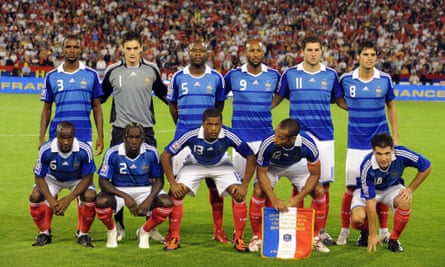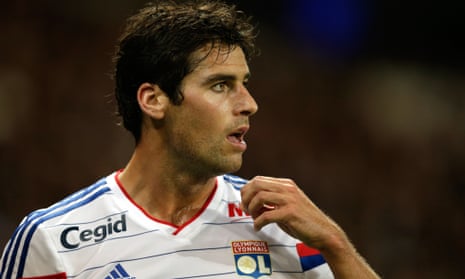Lyon are 1-0 up at home to Metz and labouring when a lofted pass from Nabil Fekir finds Yoann Gourcuff in space on the left-hand edge of the penalty area. He brings the ball down deftly and throws a step-over to unbalance Metz defender Jonathan Rivierez, only for a posse of four opponents to force him towards the corner flag. The opening appears to have closed up, but Gourcuff holds off Rivierez and manages to drill a low pass to Corentin Tolisso, who steadies himself before shooting into the bottom-left corner from 25 yards.
At first glance, the goal seems all Tolisso’s own work, but it is the pace of Gourcuff’s pass that creates the opportunity. Tolisso is too far from goal to shoot first-time, but Gourcuff knows that by fizzing the ball into his feet at speed, Metz’s defence will be caught off-guard and the young midfielder, an accomplished striker of the ball, will have time to pick his spot.
Though incidental, the assist bore all Gourcuff’s hallmarks, showcasing his sensitivity to the precise technical requirements of each on-pitch situation. Every action he performs seems delicately calibrated, from the deliberate way he paces backwards before taking set-pieces to his habit of bobbing on his toes at the start of his run-up and the exaggerated follow-through when he strikes the ball. Sadly for Gourcuff, and for Lyon, he is also uniquely sensitive to the condition of his body.
Two months after the 2-0 win over Metz, Lyon were losing 1-0 at home to Nice in March when, early in the second half, Gourcuff ballooned a shot over the bar from just outside the box. Immediately he reached for the back of his right thigh and, after a cursory word to Fekir, he walked straight off the pitch, past a disbelieving Hubert Fournier, the Lyon coach, and down the tunnel. Caught by surprise, Lyon were obliged to play with 10 men for a few minutes until Mohamed Yattara was ready to come on. Lyon lost 2-1 and Fournier’s exasperation afterwards was palpable. “If he came off, he must be injured,” he told a group of radio journalists. “I hope he is injured.”
It was to be Gourcuff’s last appearance in a Lyon shirt. Five years after being presented to a giddy throng of 15,000 supporters at Stade Gerland following a €22m move from Bordeaux (a record between two French clubs), the 28-year-old Breton left Lyon when his contract expired at the end of June. Having been granted a monthly wage of €366,000, which at the time made him the best-paid player in France, Gourcuff is believed to have cost Lyon a grand total of €60m in transfer fees, add-ons and wages.
A litany of injuries (around 20, most of them muscular) means that in return, they recouped just 90 Ligue 1 appearances, 14 goals and 17 assists. In the 187 league games Lyon played during Gourcuff’s time at the club, he completed 90 minutes on only 23 occasions.
The elegant inspiration behind Bordeaux’s Ligue 1 and Coupe de la Ligue double in the 2008-09 season (who could forget his sensational spin, dribble and shot against a pre-Zlatan Paris Saint-Germain?), Gourcuff was anointed “Le Successeur” to Zinedine Zidane by L’Équipe and was expected to uphold a tradition of gifted French attacking midfielders stretching back from Zidane via Michel Platini to the great Raymond Kopa. Instead, his name has become a byword for chronic unreliability. He once hurt his hand getting high-fived by Alexandre Lacazette. A year ago, he sprained his ankle while reportedly out walking his dog.

Although initially supportive, Gourcuff’s Lyon team-mates became irritated by his reluctance to play when not at full capacity. “This need to be 100% in order to play is hard to understand for everyone in the team and at the club,” said Lyon captain Maxime Gonalons. “He could and should have brought much more.” Even Lyon president Jean-Michel Aulas, a staunch Gourcuff supporter, betrayed an air of weariness when he announced the midfielder’s departure, lamenting that the club had “given him everything” they could to help him succeed.
The profound changes that took place at Lyon during Gourcuff’s time there only added to his isolation. In his first season, he played alongside Hugo Lloris, Miralem Pjanić, Jean II Makoun, Ederson, César Delgado, Lisandro López, Michel Bastos, Bafétimbi Gomis, Aly Cissokho, Dejan Lovren and Jimmy Briand, a group of players brought in at a combined cost of around €140m over the preceding two and a half years, as well as the France internationals Jérémy Toulalan and Anthony Révèillere, the Sweden midfielder Kim Kallstrom and the former Brazil centre-back Cris.
But the splurge did not yield the Champions League breakthrough that Aulas had sought and with wage costs spiralling and funds required for the construction of a new stadium, the Stade des Lumières, Lyon changed tack dramatically, offloading a glut of high-earning players and replacing them with graduates from the club’s highly regarded youth system such as Fekir and Lacazette. Fournier’s young, attacking team finished second in 2014-15, unexpectedly keeping pace with PSG right up until the moment the finishing line loomed into view, and while Gourcuff made occasional contributions, they were not especially telling.
In that last, prematurely curtailed appearance against Nice, Gourcuff was one of only five players in Lyon’s team who had not come through the club’s youth system, the others being the less than heralded quartet of Christophe Jallet, Bakary Koné, Lindsay Rose and Mouhamadou Dabo. Here he was again, the odd man out, the doe-eyed enigma, criticised by Paolo Maldini for failing to adapt to life at Milan (Carlo Ancelotti branded him “egocentric”) and marginalised by France’s senior players during their ill-fated 2010 World Cup campaign. “I’d have really liked to give him a slap, with his air of the little honest boy, the poor little unfortunate upon whom everyone wishes ill,” wrote France’s then-coach Raymond Domenech in his autobiography, Tout Seul.

Gourcuff’s irregular bursts of form, akin to the blooming of a rare-flowering plant, have occasionally prompted talk of a move to Arsenal, but three French teams are thought to head the queue for his signature: Rennes, his formative club, who sold him to Milan in 2006; Bordeaux, whose training facilities he has been using to regain fitness; and Monaco, whose interest comes gift-wrapped with Champions League football. His agent, Didier Poulmaire, declared recently that Gourcuff just wants to be treated like a “regular player”, but despite the ever-diminishing spiral that his career has been locked in since 2010, he remains headline news.
At times it has felt as if Gourcuff must be cursed and since the turn of the year he has lost both his grandmother and Tiburce Darou, his one-time fitness coach, who died earlier this month at the age of 72. (Darou helped Gourcuff back to fitness following a serious knee injury in August 2012, which was captured in a poignant Canal+ documentary.)
Speaking earlier this year, Darou said that the players’s injury problems had acquired a “psychosomatic” element, but expressed hope that Gourcuff was not yet finished as an elite footballer. “On a football level, you can compare Gourcuff to Iniesta,” Darou said. “If he plays for a big team, alongside ball-playing players, without having to press or do this or do that, he can find himself.”

Comments (…)
Sign in or create your Guardian account to join the discussion